What is an IoT device?
An IoT device refers to any physical object or device that is connected to the Internet and that can collect, send, or receive data.
An IoT device is typically embedded with sensors and communication capabilities to interact with the physical world and other devices.
IoT devices can vary widely in their form, functionality, and application. We can find IoT devices in various domains such as smart homes, healthcare, industrial monitoring, agriculture, and more. Examples of IoT devices include smart thermostats, wearable fitness trackers, smart home security systems, industrial sensors, or connected medical devices such as blood glucose monitors or pacemakers.
